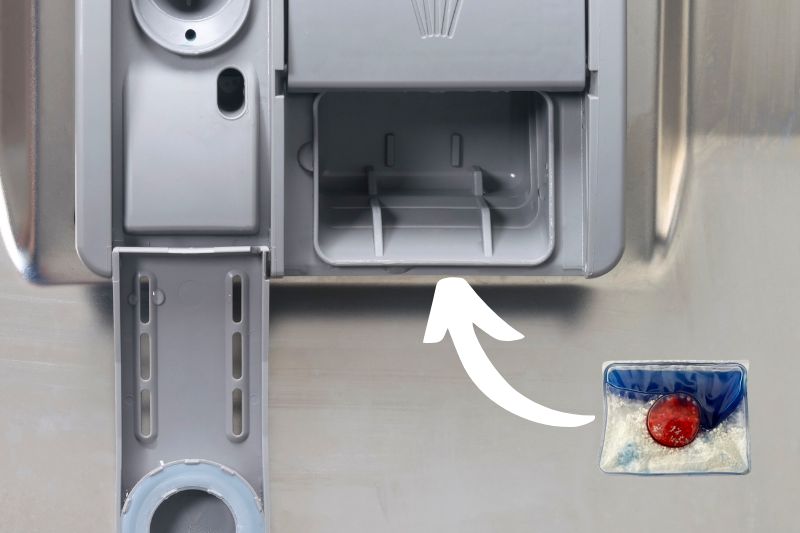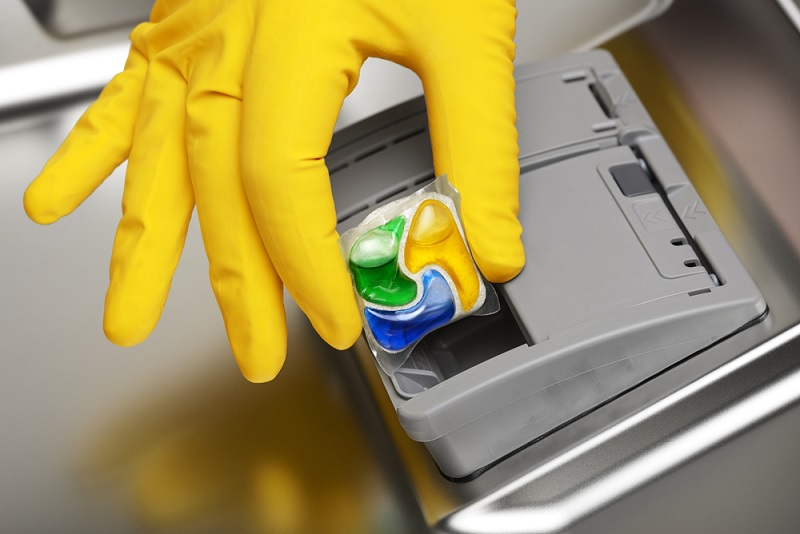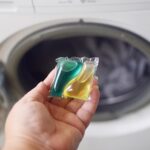Dishwashers make washing the dishes convenient and time-efficient—if used correctly!
One crucial aspect of using a dishwasher effectively is knowing where to put the detergent.
It’s well-known that dishwasher powders and gels are put in the detergent dispenser, but dishwasher power pods leave many homeowners scratching their heads.
Laundry pods are thrown into the washing machine drum, but can the same be said for dishwasher pods? Can they be thrown into the bottom of the machine or cutlery tray? Or do they need to go in the detergent dispenser?
If you don’t know where to put dishwasher pods, you’re in the right place. This guide explores the proper way to use dishwasher pods.
We also discuss other detergent options to help you find the right choice for your preferences.
Where Should You Put Dishwasher Pods?

You should put dishwasher pods in the place labelled explicitly for dishwasher detergent, known as the detergent compartment or dispenser.
These compartments open at the correct time during the wash cycle to release the detergent at the right time for maximum dish-cleaning efficiency.
The majority of standard dishwashers have a main detergent compartment located on the inside of the dishwasher door. This is the primary location for placing dishwasher pods.
Simply place the pod inside the designated area, close the compartment, and ensure it snaps shut securely.
Some modern dishwashers also come with a second detergent compartment, often situated in the door next to the main compartment. This compartment is designed for pre-wash or soaking detergents.
However, dishwasher pods are usually not meant for pre-wash, so it is best to use this compartment for dishwasher powder or gel.
Can I Just Throw a Pod in the Dishwasher?
Technically speaking, you can throw a pod into the dishwasher. In fact, many argue that this is better for the appliance, as some pods do not properly dissolve in the dispenser and leave behind a gunky residue. Not only can this clog up your machine, but it can result in your dishes coming out dirty.
However, we strongly advise against doing this. Most detergent brands use PVA as the gel casing, which readily dissolves in water.
Water circulates around the machine in the pre-rinse cycle, meaning that any dishwasher pods thrown directly in with your dishes will start to dissolve immediately.
Dishwasher detergent is not needed at the pre-rinse stage—this cycle is simply to wet the dishes and dislodge any big food particles.
Your detergent is only needed afterwards during the cleaning cycle. If the pod dissolves prematurely, this can mean that there is no detergent left for this latter stage.
The end result is that your dishes are not cleaned as effectively as if the dishwasher pod were to be placed in the detergent compartment.
This compartment releases the pod only after the pre-rinse cycle has finished, meaning that the detergent is present for the cleaning stage as intended.
Do Dishwasher Pods Clog the Dishwasher?
The people concerned about dishwasher pods clogging their appliances do have a valid argument.
If the gel casing doesn’t entirely dissolve, the sticky film left behind can clog your machine and damage the plumbing. This is especially true if the gunk is left to build up repeatedly over multiple washes.
Fortunately, placing the dishwasher pods in the appropriate place in your machine – inside the detergent compartment – should help you avoid damage.
Other things you can do to stop the pods from clogging your dishwasher include the following:
- Always handle dishwasher pods with dry hands and ensure the dispenser compartment is dry before inserting the pod. This prevents the pods from partially dissolving in the dispenser and leaving behind gunk.
- Always check the detergent dispenser for sticky residue after each use. If there is any gunk, wipe it away with a damp cloth and dry the compartment using a paper towel. This prevents the residue from accumulating and clogging the machine.
- Always use reputable brands of dishwasher pods, such as Finish Quantum Ultimate Dishwasher Tablets. These are designed to dissolve quickly in water, even if your dishwasher runs on a quick or eco-cycle.
Why Aren’t My Dishwasher Tablets Dissolving?
If you’ve put the dishwasher pod in the correct place and are still having issues with the tablet dissolving, there might be another issue at hand. Check the following to ensure your dishwasher is working as efficiently as it can be:
- Spray arms: The spray arms are crucial for distributing water around the dishwasher. Check that your dishwasher is loaded correctly so the arms can rotate freely. You should also inspect for cracks or signs of damage and clean the spray arms to ensure no food particles are blocking the water nozzles.
- Water pressure: Low water pressure can mean your dishwasher is not filling with enough water, and the dishwasher pod might fail to dissolve. Check that the pipe supplying water to your dishwasher has no kinks. If you notice that the dishwasher isn’t filling with water, consider calling a professional.
- Water temperature: Most dishwasher pods need high-temperature water to dissolve properly. Try using a hotter wash cycle to see if it helps. If it doesn’t, your dishwasher might not be heating up. We recommend calling an engineer to check that the appliance reaches higher temperatures.
Other Types of Dishwasher Detergent

Dishwasher pods are only one of the many types of available detergents, and they’re not for everyone.
If you’re having difficulties using pods, here are the main alternatives to consider:
- Dishwasher tablets: Dishwasher tablets are the most closely related detergents to dishwasher pods. Some tablets are coated in PVA that needs to dissolve, but others have no casing. They’re convenient and can be placed directly in the dispenser.
- Dishwasher powder: Dishwasher powder is a granulated detergent that is poured directly into the dishwasher’s detergent dispenser. It is economical, and you can adjust the amount of detergent as needed.
- Dishwasher gel: This type of detergent comes in a liquid or gel form and is also added directly to the dishwasher dispenser. Dishwasher gel works well for quick and short cycles and typically costs less than dishwasher pods.
- Eco-friendly detergents: The PVA coating of dishwasher pods releases plastic into the environment. Therefore, many manufacturers offer eco-friendly dishwasher detergents, which are free from harsh chemicals and use biodegradable ingredients.
Other Tips for Getting the Most Out of Your Dishwasher

Proper dishwasher detergent placement is essential, but there are additional tips to ensure optimal dishwasher performance:
- Scrape off excess food: Before loading dishes into the dishwasher, it is crucial to scrape off excess food particles to prevent clogging the dishwasher filter and ensure proper cleaning.
- Load dishes properly: Organise dishes strategically, ensuring they don’t block the spray arms’ rotation. Follow the dishwasher manufacturer’s guidelines for the best loading practices.
- Use the right detergent amount: When using dishwasher powder or gel, measure the appropriate amount to prevent wastage and avoid potential residue on dishes. For dishwasher pods, one pod is typically enough for a standard load.
- Check water temperature: Ensure that your dishwasher’s water temperature is at least 49°C. This will help the detergent dissolve effectively and clean your dishes thoroughly.

Hannah has a passion for cleaning. She worked her way around Australia by cleaning hostels in exchange for free accommodation and used her cleaning skills to bag a job as a chalet host for a luxury ski company in France.






